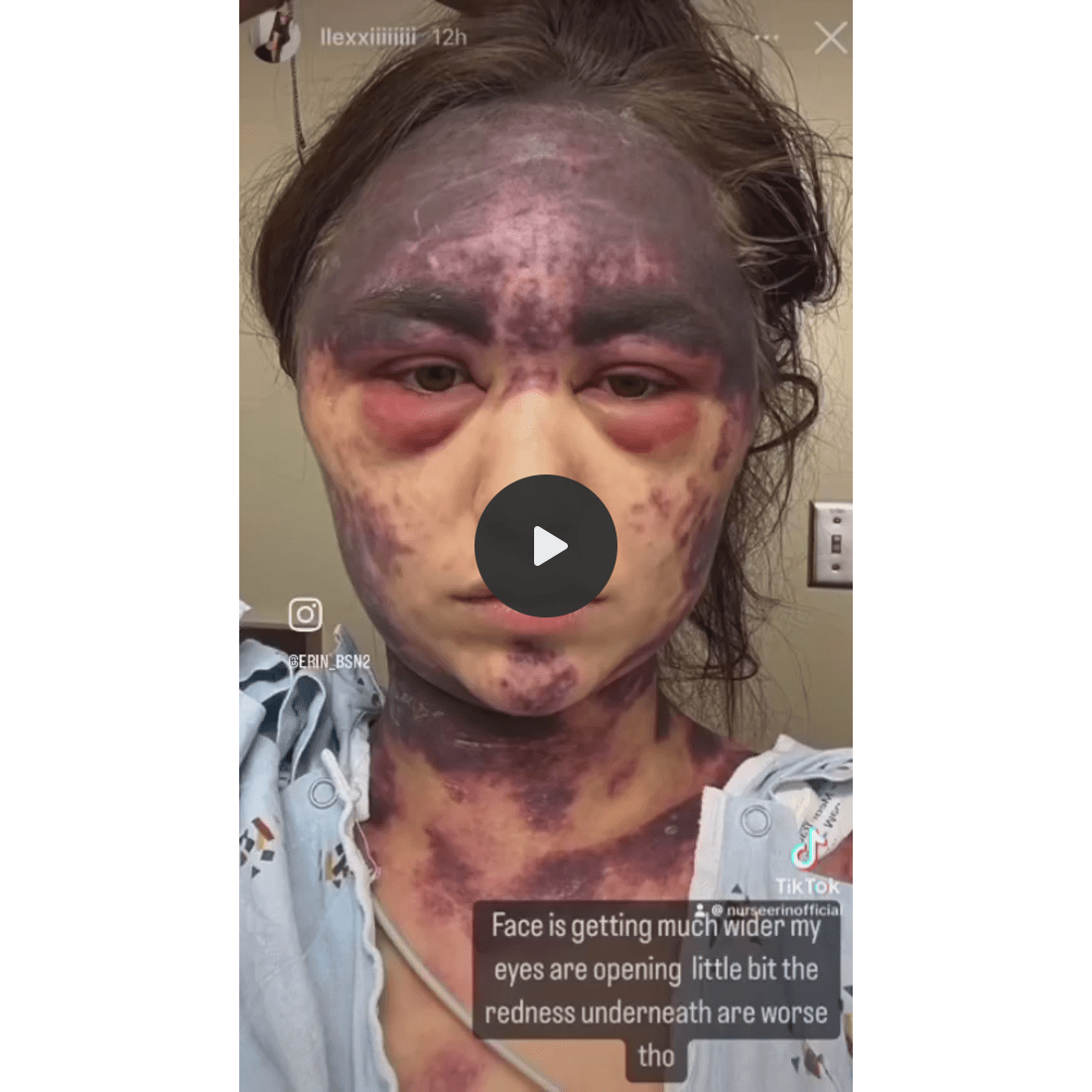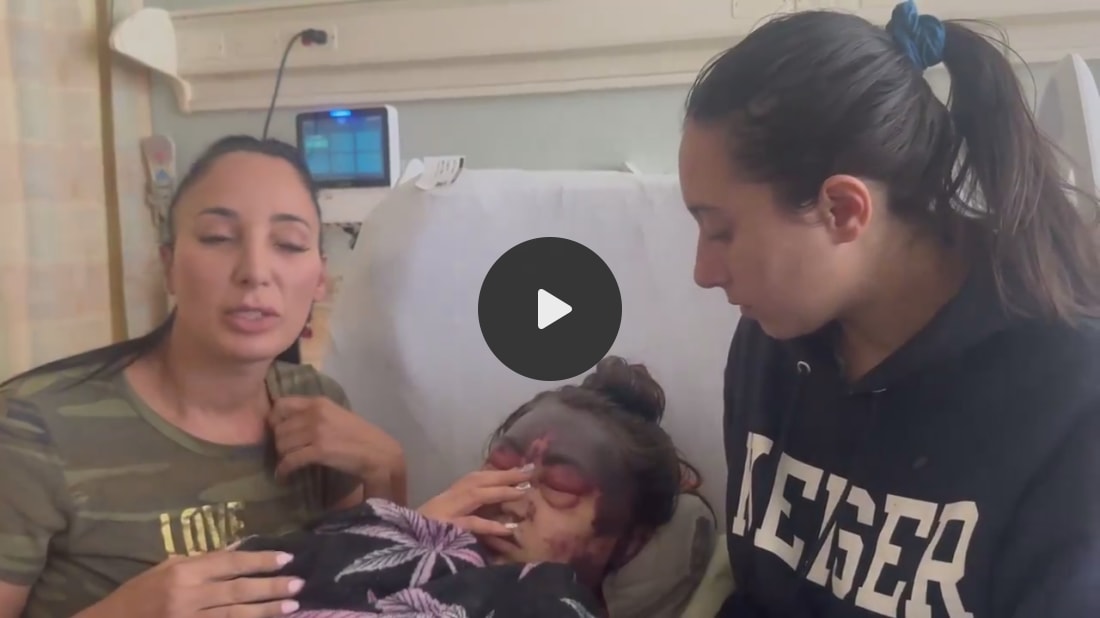What Happens When a Hospital Vaccine Injures You? A Difficult but Valuable Read, including Experiences of a Remarkable Doctor
Wed 3:15 pm +00:00, 18 Sep 2024| After finishing the first part of the DMSO series (which explains how millions of permanent disabilities and deaths from strokes, traumatic brain injuries and spinal cord injuries could have been prevented if the FDA hadn’t blacklisted DMSO), I decided to take a technology break. However, as I was drifting to bed last night, a lot of people began contacting me about a disaster that was unfolding in California.
What I find astounding about this case is that within minutes of looking into the limited information that was available, I was relatively certain of what happened, and now that her basic labs were posted online, it was indeed what happened. However, as best as I can tell, a fairly straightforward (conventional) diagnosis was missed and Alexis Lorenze has instead been put at risk of a life threatening injury. I was initially in disbelief this was possible (and to an extent still am), but people directly connected to the situation confirmed this indeed is the case. As this case is an instructive example of medical blindness, I felt it would be helpful to share what happened. Note: premier academic hospitals, while less likely to have a compassionate and caring relationship with their patients, are normally better at recognizing less common diagnoses and are typically equipped with the specialized services needed to address those situations—all of which makes me particularly surprised this was missed. To some extent, I am juxtaposing my understanding of the Midwestern academic centers onto this situation, so if you are directly familiar with the UC hospital system (particularly Irvine) and there’s is something I am missing here, please let me know. Medical BlindnessA major in medicine is that doctors are frequently unable to recognize conditions which: •Create cognitive dissonance for them (e.g., by forcing them to acknowledge they hurt a patient or accept that the guidelines their medical tribe gave them are flawed). •They were not taught to identify to recognize (as there is so much complexity to a human being, the majority of physicians lack the innate capacity to see things they weren’t taught to filter for or the willing to seriously consider the significance of things which do not make sense within their cognitive map of the world). Because of this, physicians frequently fail to recognize a pharmaceutical injury is occurring or believe a patient who claims an injury was linked to a pharmaceutical (particularly since medical education conveniently does not train doctors to recognize these injuries and simultaneously trains them to believe anything patients report that is not backed by science is “anecdotal” and most likely a spontaneous coincidence). This in turn leads to the tragic phenomenon of “medical gaslighting” (discussed further here) something many patients understandably find infuriating. This issue is particularly common with vaccines because: •The meaningless slogan “safe and effective” has been used to market them for decades regardless of how much evidence of harm exists (e.g., I previously listed some fairly tragic examples that ultimately go back over a century). Because of this, the majority of doctors assume vaccines are 100% safe and that no possible issue can emerge from giving them ad-infinitum. •To maintain the mythology of “safe and effective,” a massive embargo existing on publishing any information which is critical of vaccine safety. For example, here I presented numerous independently conducted studies which all show that vaccines cause between a 2-10 fold increase in numerous chronic diseases which have “inexplicably” spiked throughout America at the same time the vaccine schedule proliferated throughout the society (due the manufacturers being granted complete immunity from the harms of their products as they were going out of business due to the cost of injury lawsuits). •Much of the credibility of modern medicine arises from the mythologythat it rescued us from the dark ages of infectious disease with vaccinations (when in reality that decline was entirely due to improved public sanitation). Because of this, attacking vaccination directly attacks a doctors identity and social status. As a result, the medical profession will frequently go to extraordinary lengths to defend a bad vaccine they’ve endorsed—with the COVID-19 vaccines being one of the most absurd examples I’ve seen in my lifetime, but not by any means the first time this has happened. Hospital Vaccine InjuriesSuzanne Humphries (and Roman Bystrianyk) did an incredible service to the vaccine safety movement by publishing Dissolving Illusions, a book which clearly demonstrated that the mythology we were sold about vaccines saving the world was hoax, and in reality they caused far more harm than they benefitted people (discussed further here). Suzanne Humphries embarked on this project, because as a nephrologist, she kept on seeing patients enter kidney failure after a vaccine (or have their kidneys significantly worsen once they received a vaccine at a hospital). Note: Nephrologists have a somewhat unique position in medicine as if they request for a drug to be discontinued because they suspect it is harming a patients kidneys, other doctors will listen and stop the drug (whereas if a non-nephrologist points out a drug injury to a colleague, they colleague often won’t discontinue it).
Note: a key reason why hospitals push vaccines is because Obamacare, in a mission to “improve” medicine changed their financial reimbursements to reward “quality health care” and made a key component of that metric that a hospital ensured vaccinating a high percentage of their staff and patients.
Note: many of my awake colleagues joke that idiopathic denotes individuals being too idiotic to recognize the obvious cause of a disease.
Suzanne Humphries in turn was inspired to write her book “Dissolving Illusions” because one of the most common counterarguments she received from her colleagues about flu shots causing kidney failure was that “vaccines saved us from smallpox and polio so there’s no possible way a vaccine could be bad.” This in turn inspired her to look into the data underlying that claim, at which point she realized most of it wasn’t publicly available, but when she unearthed records from the basements of medical libraries, she discovered that statement was a myth, after which point she published that evidence in her book. In my own case, I’ve admitted quite a few patients to the hospital who I quickly realized were hospitalized because of a vaccine injury (e.g., including a kidney failure case like Suzanne Humphries described), and in each case, one of the biggest challenges I had was finding a way to present the case in such a way that the other doctors at the hospital would not get elgaged at me for it (e.g., I was successful in one case by attributing one injury to how the vaccine was administered rather than the vaccine itself). Note: in this publication, I’ve emphasized the forgotten medical theory that many vaccine injuries are a product of them altering the zeta potential of the body, causing blood in the body to clump together and create microstrokes which damage critical parts of the body (e.g., I’ve seen numerous cases where this happened in the brain or kidneys). Likewise, I believe one of the most common reason why people are hospitalized is because the zeta potential of their body has weakened enough that they begin developing severe symptoms which meet the criteria for hospitalization. In turn, I’ve seen textbook zeta potential collapse cases from a vaccine that resulted in hospital admission and I also believe one of the most helpful things hospitals do for patients is give them IV saline (which is just done routinely because everyone is “dehydrated”) because IV saline marginally restores the physiologic zeta potential. Alexis LorenzeAlexis Lorenze came from a family that skipped many of their later vaccines (due to an injury she experienced) and had an unfortunate genetic disorder (PNH) that causes her immune system to destroy her blood cells because they lack a protein that prevents that attack. The conventional options for the condition aren’t great—a stem cell bone marrow transplant (which produces blood cells the body won’t attack) or a monoclonal antibody that causes $400,000.00 a year. Because Alexis was desperate for an effective way to treat her condition, after months of struggling with it, she eventually came to UC Irvine for treatment, a facility which happens to be a premier adult stem cell transplant research center. When stem cell bone marrow transplants are done, they essentially require first killing off the existing bone marrow and then replacing with new bone marrow (from a donor) which unlike the old marrow, does not produce the problematic blood cells (e.g., this is a common treatment for blood cancers). Frequently when this occurs, the adaptive immunity from previous vaccinations is lost, and for this reason, many (but not all) groups recommended re-vaccinating after a bone marrow stem cell transplant, and they ofter space them out (e.g., consider what one of the countries “top” medical centers does). That said, given that most of the diseases they re-vaccinate against pose minimal risk I do not completely agree with this rationale. Note: one of the unusual characteristics of the COVID-19 vaccine was that it would accumulate in the bone marrow, and I came across cases of individuals with had a bone marrow stem cell transplant for multiple myeloma who then had their bone marrow transplant fail after the COVID vaccine. Likewise, since organ transplants are in short supply, transplant doctors prioritize people who are taking care of their health as they are the most likely to have a successful outcome with the organ. During COVID, this created the nightmarish situation where many were told they could not have a transplant unless they vaccinated, and I in turn came across numerous cases of individuals who had severe injuries, death, or failure of their transplant after the vaccination. Steve Kirsch briefly outlines what happened to Alexis
At this point, the hospital did nothing except put her on pain meds and benadryl, and eventually she put out a plea for help on TikTok to save her from the hospital because she was worried she was going to die that subsequently went viral (hence why I was contacted). Without knowing anything beyond what was in that video, my immediate assessment was:
Given that ITP is a known complication of stem cell transplants, it is again very strange that the hospital (a premier stem cell transplant center) did not recognize an extreme case of the disorder. Once her limited labs were obtained (which can be viewed here), it was clear she had ITP, and that at least at the time, there was not a significant issue with her kidneys (ruling out #3). Note: in her medical records, there are also numerous correspondences indicating that a nurse reported this critical platelet lab value to the doctor. Additionally, beyond it being apparent from looking at her, her lab work showed she was having a lot of clots breaking down in her body. Note: other blood coagulation parameters were also abnormal (e.g., her PT was 15.6 and her INR was 1.36). Additionally, she was anemic (due to her PNH). Based on all of this and how ITP is managed, I was very confused as to why nothing was done (besides giving her pain killers), so I went to look up the standard management of ITP to make sure I was not missing something. Since that time, this story has gone viral, Steve Kirsch sent his team to the hospital to help her and two subsequent interviews were conducted which showed how much Alexis is suffering. In the first interview (which you can view here), they shared a few key points: •She came in hoping for a blood transfusion, but was told she could not have any more treatment unless she received the vaccines. •The hospital has given conflicting messages about what vaccines she received (even though the nurse clearly told them which ones were being given). •Alexis’s entire body is covered with the same hematomas you can see on her face and her body feels as though it is inflated. Additionally, she is in severe pain. •The doctors have not treated her well (she claims some laughed at her, while another one stated they had never seen anything like this before) and that when she’s hit the call button for basic things she needs, it’s taken hours for nurses to get to her. •The hospital is convinced this could not have been due to the vaccine, and instead was due to a Parvovirus infection (which a PCR test was positive for). Given that all or her symptoms started 10 minutes after the vaccines…that’s a bit of a stretch but no different from what Suzanne Humphries experienced. •The tried to transport her out of the hospital but were unable to as she does not have the insurance to get care at another facility. In the last few hours, they at last were able to get Alexis transferred to the ICU, either due to the political pressure being placed on the hospital from the story going viral on Twitter or because she had, Nurse Angela, a skilled advocate helping her (which is often what is needed to get proper care in these larger institutions). ConclusionI am very hesitant to ascribe motives to people when I can’t read their minds, but in this case, assuming the facts as presented are true, my best guess is that the hospital’s response to Alexis was a combination of fear (especially once she mentioned “malpractice”), uncertainty and paralysis over her situation (e.g., the hematologist who pushed the vaccines on her disappeared), and provides an excellent illustration of why, if you have the choice, smaller rural hospitals rather than academic ivory towers are often much better to go to. One of the more telling aspects of this story was the hospital threatening to sue Steve Kirsch for publishing Alexis’s medical records (which legally they can’t do), which in turn illustrates that the hospital’s focus is on protecting itself rather than the patient. In this case, I believe it sheds a light on four very crucial points. First, as Suzanne Humphries showed, it is incredibly difficult for doctors to accept that vaccines could be harmful because it goes so against their deep seated beliefs. In turn, even when the COVID vaccines have killed and crippled large numbers of people (which has been enough to wake many doctors up) other doctors I know are still not willing to acknowledge the vaccine is dangerous (e.g., I know one doctor I think in many ways is a great physician who still supports vaccines even though two of the three members of his immediate family had severe and unambiguous reactions to them). My best guess is that the hematologist who pushed the vaccines on her could not conceive of the possibility they could be harmful (hence why he said to take all of them at once rather than one at a time) and then withdrew from the situation once something bad happened. Second, in most cases, things like this get swept under the rug (which is a large part of why doctors are convinced serious vaccine reactions are “1 in a million”). Fortunately, due to the new media climate social media (particularly Twitter) has enabled, it’s getting much harder to do that. In turn, while what happened to Alexis is extremely unfortunately, unlike those before her, she was able to publicize it and get something done about her situation, and it is my hope this will bring greater awareness to the possibility vaccines are indeed quite real. Third, one of the greatest challenges in getting people to believe vaccine injuries is that “evidence” for them doesn’t exist or it’s hard to appreciate the suffering the person is going through. What makes this case unique is that it visually apparent something is wrong (which hence allowed it to go viral) and the temporal relationship is almost impossible to deny. What’s important to remember is that in almost all vaccine injuries, that is not the case (which again illustrates why they frequently get swept under the rug). Fourth, if something does go awry with a vaccine, there is often minimal to no safety net available to you (e.g., you can’t sue anyone and the Federal compensation programs almost never pay out to the injured). Because of this, those injured are often forced to go to online fund raising platforms for their medical expenses (which often doesn’t works). In turn, one of the particularly cruel things that happened during the vaccine roll out is that Gofundme started deleting fundraisers for the COVID vaccine injuries because a lot of them went viral and they didn’t want to “spread vaccine hesitancy” by making people aware severe injuries were occurring. Note: Alexis has a fundraiser on this (more ethical) platform. Finally (since I am still having trouble wrapping my head around all of this), if any of you have familiarity with the UC hospital system (particularly UC Irvine), this midwestern doctor would appreciate your insights into the hospital culture there (and sincerely appreciates the help all of you have given me to help get critical messages like this out). |




















